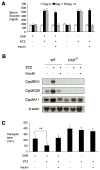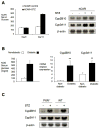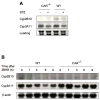Constitutive androstane receptor mediates the induction of drug metabolism in mouse models of type 1 diabetes
- PMID: 19489075
- PMCID: PMC2721020
- DOI: 10.1002/hep.23025
Constitutive androstane receptor mediates the induction of drug metabolism in mouse models of type 1 diabetes
Abstract
Untreated type 1 diabetes increases hepatic drug metabolism in both human patients and rodent models. We used knockout mice to test the role of the nuclear xenobiotic receptors constitutive androstane receptor (CAR) and pregnane and xenobiotic receptor (PXR) in this process. Streptozotocin-induced diabetes resulted in increased expression of drug metabolizing cytochrome P450s and also increased the clearance of the cytochrome P450 substrate zoxazolamine. This induction was completely absent in Car(-/-) mice, but was not affected by the loss of PXR. Among the many effects of diabetes on the liver, we identified bile acid elevation and activated adenosine monophosphate-activated protein kinase as potential CAR-activating stimuli. Expression of the CAR coactivator peroxisome proliferator-activated receptor gamma coactivator (PGC)-1alpha was also increased in mouse models of type 1 diabetes.
Conclusion: The CAR-dependent induction of drug metabolism in newly diagnosed or poorly managed type 1 diabetes has the potential for significant impact on the efficacy or toxicity of therapeutic agents.
Figures






Similar articles
-
The constitutive androstane receptor and pregnane X receptor function coordinately to prevent bile acid-induced hepatotoxicity.J Biol Chem. 2004 Nov 19;279(47):49517-22. doi: 10.1074/jbc.M409041200. Epub 2004 Sep 8. J Biol Chem. 2004. PMID: 15358766
-
Phenobarbital induces cell cycle transcriptional responses in mouse liver humanized for constitutive androstane and pregnane x receptors.Toxicol Sci. 2014 Jun;139(2):501-11. doi: 10.1093/toxsci/kfu038. Epub 2014 Apr 1. Toxicol Sci. 2014. PMID: 24690595
-
Regulatory cross-talk between drug metabolism and lipid homeostasis: constitutive androstane receptor and pregnane X receptor increase Insig-1 expression.Mol Pharmacol. 2008 Apr;73(4):1282-9. doi: 10.1124/mol.107.041012. Epub 2008 Jan 10. Mol Pharmacol. 2008. PMID: 18187584
-
Nuclear receptors PXR and CAR: implications for drug metabolism regulation, pharmacogenomics and beyond.Expert Opin Drug Metab Toxicol. 2013 Mar;9(3):253-66. doi: 10.1517/17425255.2013.754010. Epub 2013 Jan 17. Expert Opin Drug Metab Toxicol. 2013. PMID: 23327618 Review.
-
The xenobiotic receptors PXR and CAR in liver physiology, an update.Biochim Biophys Acta Mol Basis Dis. 2021 Jun 1;1867(6):166101. doi: 10.1016/j.bbadis.2021.166101. Epub 2021 Feb 15. Biochim Biophys Acta Mol Basis Dis. 2021. PMID: 33600998 Free PMC article. Review.
Cited by
-
Modulation of CYP3a expression and activity in mice models of type 1 and type 2 diabetes.Pharmacol Res Perspect. 2014 Dec;2(6):e00082. doi: 10.1002/prp2.82. Epub 2014 Sep 1. Pharmacol Res Perspect. 2014. PMID: 25505621 Free PMC article.
-
PPARα Induces the Expression of CAR That Works as a Negative Regulator of PPARα Functions in Mouse Livers.Int J Mol Sci. 2023 Feb 16;24(4):3953. doi: 10.3390/ijms24043953. Int J Mol Sci. 2023. PMID: 36835365 Free PMC article.
-
Pregnancy represses induction of efflux transporters in livers of type I diabetic mice.Pharm Res. 2013 Sep;30(9):2209-20. doi: 10.1007/s11095-013-0981-z. Epub 2013 Jan 15. Pharm Res. 2013. PMID: 23319174 Free PMC article.
-
Streptozotocin-induced Diabetes Represses Hepatic CYP2R1 Expression but Induces Vitamin D 25-Hydroxylation in Male Mice.Endocrinology. 2022 Jul 1;163(7):bqac060. doi: 10.1210/endocr/bqac060. Endocrinology. 2022. PMID: 35524739 Free PMC article.
-
A Diet-Sensitive BAF60a-Mediated Pathway Links Hepatic Bile Acid Metabolism to Cholesterol Absorption and Atherosclerosis.Cell Rep. 2015 Nov 24;13(8):1658-69. doi: 10.1016/j.celrep.2015.10.033. Epub 2015 Nov 12. Cell Rep. 2015. PMID: 26586440 Free PMC article.
References
-
- Remmer H, Merker HJ. Drug-Induced Changes In The Liver Endoplasmic Reticulum: Association With Drug-Metabolizing Enzymes. Science. 1963;142:1657–1658. - PubMed
-
- Willson TM, Kliewer SA. PXR, CAR and drug metabolism. Nat Rev Drug Discov. 2002;1:259–266. - PubMed
-
- Sonoda J, Rosenfeld JM, Xu L, Evans RM, Xie W. A nuclear receptor-mediated xenobiotic response and its implication in drug metabolism and host protection. Curr Drug Metab. 2003;4:59–72. - PubMed
-
- Honkakoski P, Sueyoshi T, Negishi M. Drug-activated nuclear receptors CAR and PXR. Ann Med. 2003;35:172–182. - PubMed
-
- Qatanani M, Moore DD. CAR, the continuously advancing receptor, in drug metabolism and disease. Curr Drug Metab. 2005;6:329–339. - PubMed
Publication types
MeSH terms
Substances
Grants and funding
LinkOut - more resources
Full Text Sources
Medical
Molecular Biology Databases
